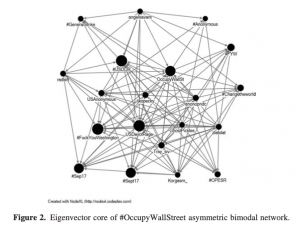Using Network Analysis to Explore How Social Movements Emerge on Twitter: A Case Study of Occupy Wall Street
As computerization becomes the zeitgeist of contemporary society, individual behaviors on social media have more echoes than ever before. This creates a strong potential for anything happening online to be amplified, and the following consequences include many that would have a huge influence on society, for example, social movements. At the core of the spread of these online collective actions are the networks established intrinsically to aid the diffusion of opinions. With this logic, using network analysis to demystify the emergence of social movements has been lucrative for computational social scientists to practice in the status quo. With a detailed analysis, Mark Tremayne has utilized one of the earliest examples of online social movements that have been substantialized with collective human actions in reality: Occupy Wall Street.
Mark adopted social network analysis and gathered data from the earliest stage of Occupy Wall Street on Twitter. By integrating 4995 messages to establish the network, he has dug up the data with some calculations of out-degree centrality and in-degree centrality, which separately indicate a node’s connection to other nodes via message sending and the frequency of a node is targeted with messages (and @mentions). This reminds me of the notion of hub and authority scores learned in class. To examine which nodes have the highest in-degree and out-degree centralities, we will be able to know the structure of the network, especially after the layout by degree weighing, and the center of the networks. This also supported Mark’s argument on the uniqueness of social movements emerging on social media that the most active users in these movements are not the best leaders. Their high in-degree and out-degree centrality indicate that they are the agency to spread the information rather than the one who guides the whole movement.
This argument was supported more solidly through Mark’s analysis on the betweenness centrality and eigenvector centrality, and the different phases of the social movements. As demonstrated below in the graph, betweenness and eigenvector centrality concern more dynamics within the hubs and authorities within such a network system. Some of the biggest eigenvector cores of the graph, namely #FuckYouWashington and #OccupyWallSt were not even connected at the beginning of its spread. These two hashtags were used separately at the beginning of this social movement. However, as a supernode coincidentally linked these two hashtags together, a brokerage is established for the original opinions about Occupy Wall Street to spreading further. As the brokerage introduced a bridge between two notions, a further degree of diffusion is established with the scale shift effect on more users.
From this case study, I learned that the diffusion of information and scale shift is not only tied to the advertising effect that we learned in class. Analyzing this from the perspective of social movements, I realized the potential of using social network analysis to either encourage or regulate the emergence of social movements through creating or repressing brokerages.
Source: Mark Tremayne (2014) Anatomy of Protest in the Digital Era: A Network Analysis of Twitter and Occupy Wall Street, Social Movement Studies, 13:1, 110-126, DOI: 10.1080/14742837.2013.830969

